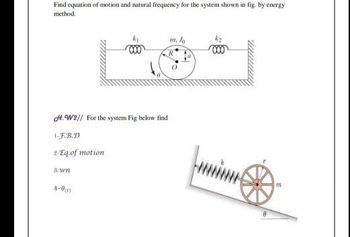
Elements Of Electromagnetics
7th Edition
ISBN: 9780190698614
Author: Sadiku, Matthew N. O.
Publisher: Oxford University Press
expand_more
expand_more
format_list_bulleted
Question

Transcribed Image Text:Find equation of motion and natural frequency for the system shown in fig. by energy
method.
H.W2// For the system Fig below find
1-F.B.D
2-Eq.of motion
8wn
4-0 (5)
m. Jo
m
Expert Solution
This question has been solved!
Explore an expertly crafted, step-by-step solution for a thorough understanding of key concepts.
Step by stepSolved in 2 steps with 4 images

Knowledge Booster
Similar questions
- See the attached image. Please provide the solution modeled as a differential equation. Include an equation of motion of the mass for both no damping force and a damping resistance equal to half the velocity (please notate and show how to identify the velocity) with detailed steps and explanation of the solution.arrow_forwardFast pls solve this question correctly in 5 min pls I will give u like for sure Sini.arrow_forward6. The electro-mechanical system shown below consists of an electric motor with input voltage V which drives inertia I in the mechanical system (see torque T). Find the governing differential equations of motion for this electro-mechanical system in terms of the input voltage to the motor and output displacement y. Electrical System puthiy C V V₁ R bac (0) T bac T Motor - Motor Input Voltage - Motor Back EMF = Kbac ( - Motor Angular Velocity - Motor Output Torque = K₂ i Kbacs K₁ - Motor Constants Mechanical System M T Frictionless Supportarrow_forward
- 3. Suppose the model of a vehicle suspension is given below. Write the equation of motion in matrix form (not in State Space form). Calculate the natural frequencies for k₁ k2 10 N/m, m2 = 50kg, and m₁ = 2000kg. -= - - 103 N/m, 1 x1(c) m1 www m1 Car mass k₁ Car spring k1 k₂ Tire stiffness www x2(1) m2 Tire mass м2 k₂ ↑arrow_forwardrelated to vibration dont copyarrow_forwardWhats the first equation (circled) and how did we get it ?arrow_forward
- Ex. A vehicle wheel, tire and suspension assembly can be modeled crudely as a single degree of freedom spring mass system. The mass of the assembly is measured to be about 300kg. its frequency of oscillation is observed to be π rad/sec. What is the approximate stiffness of the tire, wheel and suspension assembly? ilippines) Accessibility: Investigatearrow_forwardConsider the double mass/double spring system shown below. - click to expand. Both springs have spring constants k, and both masses have mass m; each spring is subject to a damping force of Ffriction -cz' (friction proportional to velocity). We can write the resulting system of second-order DEs as a first-order system, t' (t) = Au(t), with = (₁, 21, 22, 2₂) I For values of k = 4, m = 1 and c = 1, the resulting eigenvalues and eigenvectors of A are -0.039-0.248i 0.813 A₁2=-0.5±3.2i, v₁ = 0.024 +0.153i -0.502 -0.134-0.302i 0.409 -0.2160.489 0.661 (a) Find a set of initial displacements (0), 2(0) that will lead to the fast mode of oscillation for this sytem. Assume that the initial velocities wil be zero. A3,4 -0.5± 1.13i, z = and (2₁ (0), ₂(0)) = Enter your answer using angle braces, (and). (b) At what frequency will the masses be oscillating in this mode? Frequency rad/sarrow_forwardDerive a model for the mechanical system represented below. The input being the force F and the output the displacement x. Determine the time response, x(t) when F is an impulse force of 100 Newton. K-50 kg/s² M=10 kg B-60 kg/s F (Vol Ans: x(t) = 2.5(e¹ - es)arrow_forward
- 1 ) Derive a free body diagram with spring-mass-damper elements for given system. QUESTION 2 ) Derive equation of motion for given system in terms of m, c, k.arrow_forwardll b) Obtain the mathematical model of the system shown in Figure Q2b using Newton's second law of motion, F=ma. k₁ w 3- 777777 C1 7771 k₂ D 7777 Figure: Q2b Page 2 of 7 A C2 1112arrow_forwardrelated to vibrationarrow_forward
arrow_back_ios
SEE MORE QUESTIONS
arrow_forward_ios
Recommended textbooks for you
 Elements Of ElectromagneticsMechanical EngineeringISBN:9780190698614Author:Sadiku, Matthew N. O.Publisher:Oxford University Press
Elements Of ElectromagneticsMechanical EngineeringISBN:9780190698614Author:Sadiku, Matthew N. O.Publisher:Oxford University Press Mechanics of Materials (10th Edition)Mechanical EngineeringISBN:9780134319650Author:Russell C. HibbelerPublisher:PEARSON
Mechanics of Materials (10th Edition)Mechanical EngineeringISBN:9780134319650Author:Russell C. HibbelerPublisher:PEARSON Thermodynamics: An Engineering ApproachMechanical EngineeringISBN:9781259822674Author:Yunus A. Cengel Dr., Michael A. BolesPublisher:McGraw-Hill Education
Thermodynamics: An Engineering ApproachMechanical EngineeringISBN:9781259822674Author:Yunus A. Cengel Dr., Michael A. BolesPublisher:McGraw-Hill Education Control Systems EngineeringMechanical EngineeringISBN:9781118170519Author:Norman S. NisePublisher:WILEY
Control Systems EngineeringMechanical EngineeringISBN:9781118170519Author:Norman S. NisePublisher:WILEY Mechanics of Materials (MindTap Course List)Mechanical EngineeringISBN:9781337093347Author:Barry J. Goodno, James M. GerePublisher:Cengage Learning
Mechanics of Materials (MindTap Course List)Mechanical EngineeringISBN:9781337093347Author:Barry J. Goodno, James M. GerePublisher:Cengage Learning Engineering Mechanics: StaticsMechanical EngineeringISBN:9781118807330Author:James L. Meriam, L. G. Kraige, J. N. BoltonPublisher:WILEY
Engineering Mechanics: StaticsMechanical EngineeringISBN:9781118807330Author:James L. Meriam, L. G. Kraige, J. N. BoltonPublisher:WILEY

Elements Of Electromagnetics
Mechanical Engineering
ISBN:9780190698614
Author:Sadiku, Matthew N. O.
Publisher:Oxford University Press

Mechanics of Materials (10th Edition)
Mechanical Engineering
ISBN:9780134319650
Author:Russell C. Hibbeler
Publisher:PEARSON

Thermodynamics: An Engineering Approach
Mechanical Engineering
ISBN:9781259822674
Author:Yunus A. Cengel Dr., Michael A. Boles
Publisher:McGraw-Hill Education

Control Systems Engineering
Mechanical Engineering
ISBN:9781118170519
Author:Norman S. Nise
Publisher:WILEY

Mechanics of Materials (MindTap Course List)
Mechanical Engineering
ISBN:9781337093347
Author:Barry J. Goodno, James M. Gere
Publisher:Cengage Learning

Engineering Mechanics: Statics
Mechanical Engineering
ISBN:9781118807330
Author:James L. Meriam, L. G. Kraige, J. N. Bolton
Publisher:WILEY